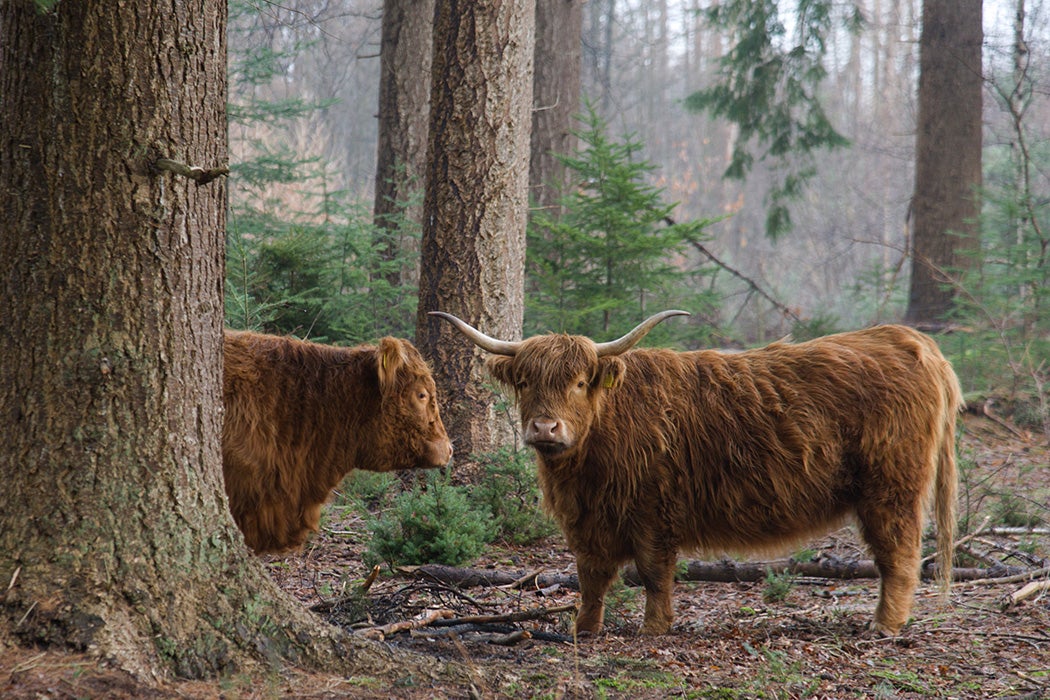Cows belong in pastures, right? While that image is idyllic, farmers and conservationists in the southeast United States are bringing their cows into the forest to benefit longleaf pine restoration projects.
In a review paper, researchers Christopher R. Keyes and Matthew G. Keyes examine the economic viability and ecological success of silvopasture in the southeastern United States. Cows in forests, they find, could benefit ecosystems and farmers alike.
Silvopasture is a type of agroforestry, or agricultural forestry, where cows graze within wooded areas, eating invasive plants and helping to restore forests. It also allows farmers to simultaneously raise cattle and grow marketable timber. Keyes and Keyes call the practice an “economic opportunity” that could lead to more diverse forests and healthier cows.
Historically, longleaf pine covered 92 million acres from Texas to Virginia, but more recent estimates state the tree is found in just 2 percent of its native range. Over time, the species declined due to land conversion, fire suppression, and landowners planting more profitable tree species.
But the pine is an ecological keystone, providing habitat to many species, including the Florida mouse, gopher tortoise, and the federally endangered red-cockaded woodpecker.
Forest management often centers on growing profitable trees fast, while silvopasture takes an ecosystem-wide approach, with the goal of encouraging tree and native plant growth. Normally, a dense forest will produce a profitable timber harvest. But silvopasture encourages a thinned forest, which results in both quality trees and healthy growth of plants on the forest floor. The forage on the forest floor, in turn, supports the cattle. More open forest stands give cows room to roam and allows more sunlight and space for trees to grow faster.
Longleaf pines are naturally dependent on fire, which encourages herb growth and prevents invasive woody plants from taking hold. But since these systems have been fire-suppressed for so long, invasive plants have creeped in. Cattle grazing and open stands encourage native plant growth, but Keyes and Keyes suggest keeping herd size under control, as cows could unintentionally trample seedlings.
Managing the forest for more than one use is not new to the southeastern United States. In the sixteenth century, Spanish explorers began grazing cattle throughout forests in Florida. Today, private landowners own the bulk of longleaf pine plantations. As the authors write, “Restoration and maintenance of longleaf pine on a landscape scale can be successful only if private landowners are willing participants in the process.”
The authors state that silvopasture creates two revenue streams via trees and cattle, and the diversification of this system allows a landowner to have more flexibility than relying on one harvest alone.
Weekly Newsletter
With all the benefits of silvopasture, there are some drawbacks. Depending on the area, regulations may prohibit any practices that could impact the red-cockaded woodpecker. More research is needed to determine the long-term effects of cattle grazing on these ecosystems.
These ecosystems present a hopeful path forward for landowners and restorationists. “Longleaf pine–based silvopastoral systems offer a unique promise,” write Keyes and Keyes. “They can achieve landowners’ economic objectives…while simultaneously restoring the longleaf pine species and many of the ecological services provided by natural longleaf pine forests.”







